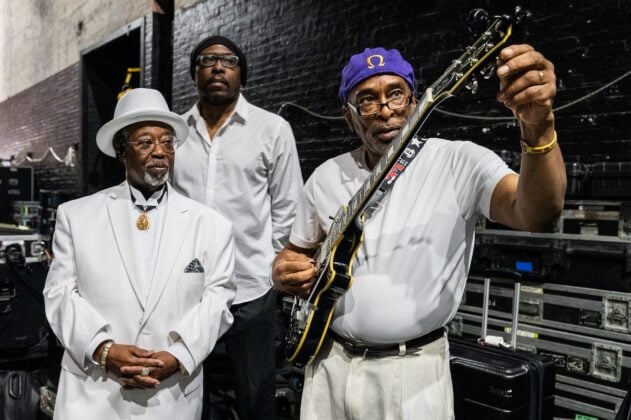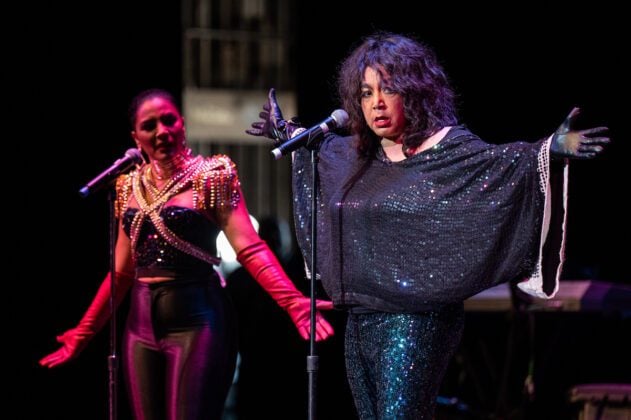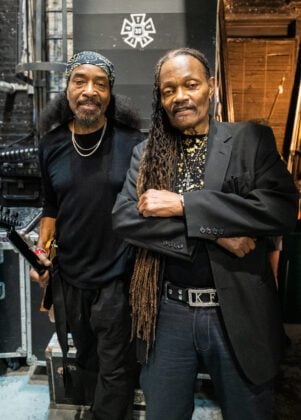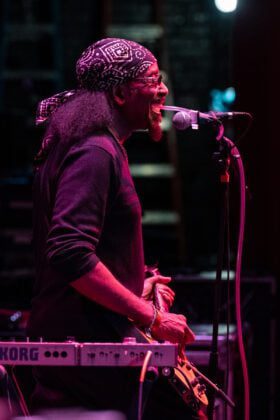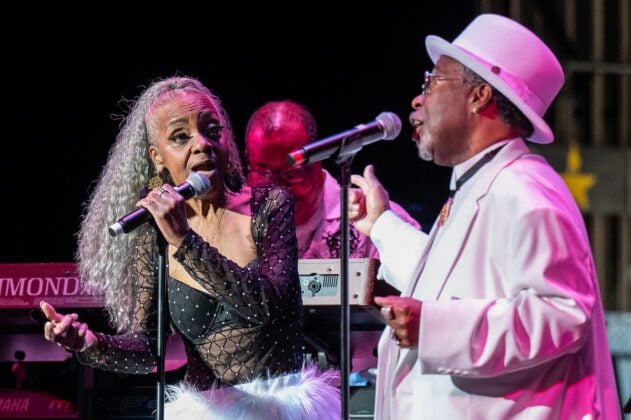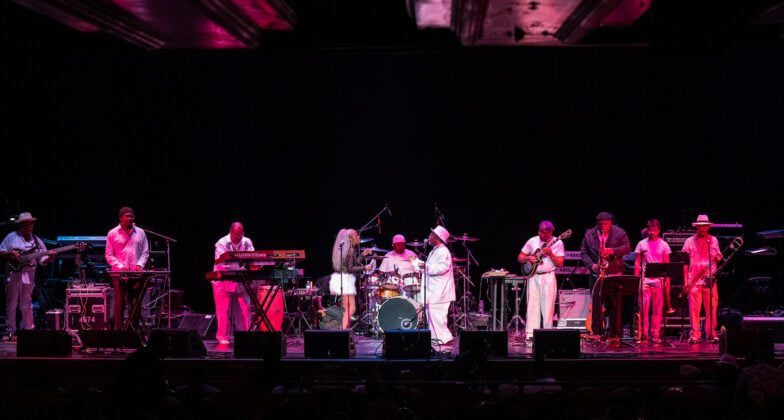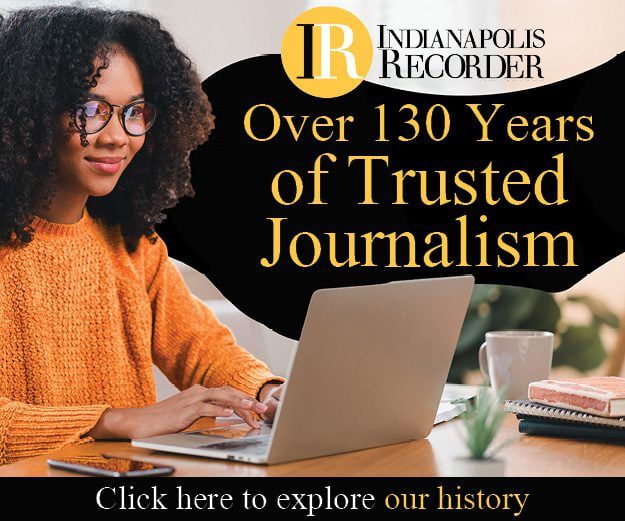Promoter Geno Shelton hit a grand slam June 18 with the Juneteenth Freedom Funk Festival. A near-capacity audience showed up to the Old National Centre for an all-star lineup of funk legends, including Lakeside, the Bar-Kays, Zapp, Trouble Funk and Klymaxx. (The Average White Band was also scheduled to appear, but canceled due to COVID-19.)
In addition to the aforementioned music luminaries, Shelton also added a pair of Naptown’s most beloved funk acts to the bill: Ebony Rhythm Funk Campaign and Circle City Band. These local funk legends will be the focus of this review.
Photos: Here’s how Indy celebrated Juneteenth
Ebony Rhythm Funk Campaign was the first act to take the stage. Ebony Rhythm holds an important place in the history of Indianapolis music. The group was founded in the late 1960s as the Ebony Rhythm Band, a largely instrumental quartet that developed a unique psychedelic funk sound that predated George Clinton’s famous Parliament-Funkadelic. Ebony Rhythm found quick success in Naptown. In addition to performing at local clubs like the 20 Grand and Blue Eagle, Ebony Rhythm became the house band for the Indianapolis-based Lamp Records label. Ebony Rhythm performed on the label’s biggest hit: The Vanguards’ “It’s Too Late For Love,” which cracked the Billboard top 40 R&B chart in 1970.
Riding high off its success with Lamp, Ebony Rhythm hit the West Coast in the early 1970s, impressing music industry veterans like Wayne Henderson of The Crusaders, who produced their debut album in 1973. By this time the band had expanded into the Ebony Rhythm Funk Campaign, adding a full horn section and multiple vocalists. Ebony Rhythm produced two classic funk LPs and a Billboard charting single, 1975’s “How’s Your Wife (And My Child),” before splitting up in the late ‘70s.
Ebony Rhythm’s appearance at the Juneteenth Freedom Funk Festival was their first performance in 15 years. Despite their long absence from the stage, Ebony Rhythm delivered a nearly flawless set, which heavily focused on tracks from their 1976 album, “Watchin’ You, Watchin’ Me.” Ebony Rhythm has lost many key members over the years, but three of the band’s founders remain — bassist Lester Johnson, keyboardist Ricky Jackson and vocalist Pam Tanner-Davis.
Ebony Rhythm assembled an impressive crew of Indianapolis musicians to fill the band out, including significant local jazz players like Rob Dixon, Reggie Bishop and Freddie Mendoza, along with veteran Naptown R&B artists including Guy Lipkins and James Blane. In short, Ebony Rhythm spared no expense in bringing its legendary sound to the stage. That effort paid off, as Ebony Rhythm provided one of the most memorable sets of the night.
The second act to take the stage was Circle City Band, best known for its classic 1983 single “Magic.” Though “Magic” never hit the Billboard charts, the song has become an underground classic with soul music fans around the world, and for many years an instrumental version of the track was used as the theme music for the BET cable network.
Circle City Band originally began as a studio project created by bassist Paul Thomas, who had previously performed with Rapture, an important Indianapolis funk band led by Rodney Stepp. As Thomas developed the Circle City sound, he recruited Reggie Griffin, a co-founder of Naptown’s famous Manchild band (the group that launched the career of Kenny “Babyface” Edmonds). Griffin is known as “Mr. Everything,” a name born from for his uncanny ability to shred on a variety of instruments, including sax, guitar and keys.
But it was Griffin’s knowledge of synths and drum machines that pulled him into the Circle City orbit. During the early ‘80s, Griffin was attracting national attention for his work in electronic music, and for a brief time he was employed as a producer for Sugar Hill Records, where he helped to create early hip-hop classics like Grandmaster Flash’s “The Message.” Griffin’s electronic motifs paired perfectly with Thomas’ funky bass music, and together they created a series of classic ’80s electro-soul singles under the Circle City name.
Thomas and Griffin were both in good spirits when they took the stage. Thomas cut a striking presence onstage, donning a massive fur coat that evoked the Superfly-era of the 1970s. Griffin was spectacular on guitar, ably demonstrating why artists like Aretha Franklin, Chaka Khan and the Isley Brothers have called on his talents as a musician and producer. One of the highlights of Circle City’s set was a special guest appearance from Manchild vocalist Kevin “Flash” Ferrell, who retains the charisma that helped elevate Manchild to national prominence during the 1970s.
As for the rest of the show? A blow-by-blow recap hardly seems necessary. Some of the greatest funk bands of all-time played some of the greatest party music ever created. Good vibes and positive energy were flowing in abundance. Audience members were dancing joyously through the aisles of the Old National Centre.
When I spoke with Geno Shelton before the event, he told me that he hoped the festival might provide an antidote to the blues and cabin fever that many folks experienced during the COVID-19 shutdown. I have no doubt that his goal was achieved.

